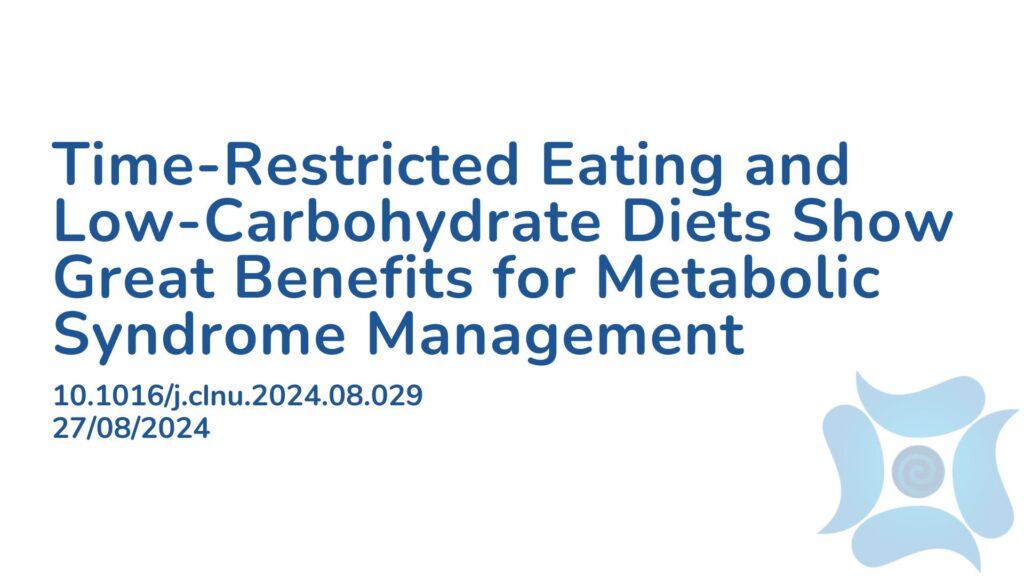Summary:
Metabolic syndrome (MetS) is characterized by obesity, hypertension, insulin resistance, and high cholesterol. MetS increases the risk of type 2 diabetes and heart disease but is also linked to poor mental health and disruptions in the gut-brain axis. Time-restricted eating (TRE) and low-carbohydrate diets (LCD) have been shown to effectively promote weight loss and improve cardiometabolic health. Individuals with MetS often experience reduced quality of life and sleep disturbances. While weight loss from dietary interventions generally improves physical health, its impact on mental health remains unclear. Some studies report benefits in quality of life, sleep, and mood with TRE and LCD, while others find no significant changes. MetS is also associated with increased appetite and problematic eating behaviors. Metabolic hormones such as ghrelin (which stimulates hunger) and GLP-1 (which promotes satiety) play a crucial role in regulating food intake. The effects of TRE and LCD on these hormones vary, and the underlying mechanisms are not fully understood. In this study, researchers previously found that TRE, LCD, and their combination improved body weight and cardiometabolic markers over three months. This secondary analysis aimed to assess the impact of these interventions on quality of life, sleep, mood, and appetite, using both self-reported data and hormone levels, to provide a more comprehensive understanding of MetS management. The study analyzed 162 participants. After 3 months, only the TRE group showed a reduction in GLP-1 levels and an increase in pancreatic polypeptide (PP) levels. The TRE group also experienced improvements in physical functioning, social functioning, mental health, and sleep efficiency. Compared to the LCD group, the TRE group had greater improvements in general health. The authors concluded that TRE, LCD, and their combination improved psychosocial health and reduced appetite, but TRE led to greater quality of life improvements in people with metabolic syndrome.
Abstract:
Background & aims: Time-restricted eating (TRE) and low-carbohydrate diet (LCD) can improve multiple cardiometabolic parameters in patients with metabolic syndrome (MetS), but their effects on psychosocial health and satiety are unclear. In this study, we aimed to evaluate the effects of TRE, LCD, and their combination (TRE + LCD) on quality of life (QoL), sleep, mood, appetite, and metabolic hormones in patients with MetS. Methods: This is a secondary analysis of a single-center, 3-month, open-label, randomized clinical trial investigating the effects of TRE, LCD, and TRE + LCD on weight and cardiometabolic parameters in individuals with MetS. This secondary analysis examined QoL, sleep, mood, and appetite using the Rand 36-Item Short Form (SF-36); Pittsburgh Sleep Quality Index (PSQI); Depression, Anxiety, and Stress Scale; and Eating Behavior Rating Scale, respectively, as well as measured levels of metabolic hormones including leptin, amylin, glucose-dependent insulinotropic polypeptide, glucagon-like peptide-1 (GLP-1), pancreatic polypeptide (PP), and peptide YY. Between-group comparisons were conducted via one-way ANOVAs and post hoc LSD tests for normally distributed variables or Kruskal‒Wallis H tests and the Nemenyi test for abnormally distributed variables. P < 0.017 was considered significant in multiple comparisons following Bonferroni adjustment. Results: A total of 162 participants (mean [SD] age, 41.2 [9.9] years; mean [SD] body mass index, 29.3 [3.4] kg/m2; 102 [63%] men) who started the intervention were analyzed. After 3 months, only the TRE group decreased GLP-1 levels (−0.9 [IQR, −1.9 to −0.3] pg/mL; P = 0.002), increased PP levels (8.9 [IQR, −7.6 to 71.8] pg/mL; P = 0.011), physical functioning in the SF-36 (5.2 [95% CI, 1.9 to 8.5]; P = 0.001), social functioning in the SF-36 (9.1 [95% CI, 2.5 to 15.6]; P = 0.005), role-physical in the SF-36 (24.1 [95% CI, 11.8 to 36.4]; P < 0.001), role-emotional in the SF-36 (22.4 [95% CI, 12.6 to 32.2]; P < 0.001), and sleep efficiency in the PSQI (0.29 [95% CI, 0.03 to 0.55]; P = 0.021). Compared with changes in LCD, TRE further increased general health in the SF-36 (9.7 [95% CI, 3.3 to 16.0]; P = 0.006). Relative to the changes of TRE + LCD, TRE significantly increased role-emotional in the SF-36 (19.9 [95% CI 4.9 to 34.8]; P = 0.006). Changes in sleep quality, mood status, appetite, and metabolic hormones did not differ among three groups. Greater weight loss was associated with decreased leptin levels (r = 0.538), decreased amylin levels (r = 0.294), reduced total appetite scores (r = 0.220), and improved general health (r = −0.253) (all P ≤ 0.01). Conclusions: TRE, LCD, and TRE + LCD all could improve psychosocial health and reduce appetite. Notably, TRE yielded greater benefits in QoL compared with LCD or TRE + LCD in individuals with MetS.
Article Publication Date: 27/08/2024
DOI: 10.1016/j.clnu.2024.08.029



